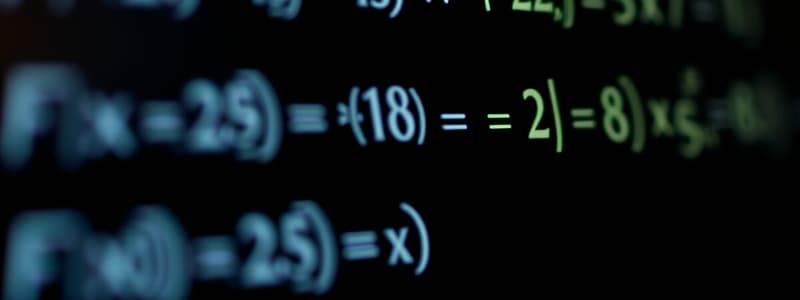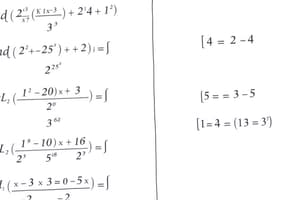Podcast
Questions and Answers
What is the domain of the Identity (Linear) Function?
What is the domain of the Identity (Linear) Function?
- (-∞, ∞) (correct)
- [0, ∞)
- (0, ∞)
- (-∞, 0)
What is the range of the Squaring (Quadratic) Function?
What is the range of the Squaring (Quadratic) Function?
[0, ∞)
The Cubing Function has vertical asymptotes.
The Cubing Function has vertical asymptotes.
False (B)
What is the local extrema of the Square Root Function?
What is the local extrema of the Square Root Function?
Match the following functions with their characteristics:
Match the following functions with their characteristics:
What is the boundedness of the Exponential Function?
What is the boundedness of the Exponential Function?
The Sine Function has a maximum value of 1.
The Sine Function has a maximum value of 1.
What is the degree of continuity for the Greatest Integer Function?
What is the degree of continuity for the Greatest Integer Function?
What is the range of the Logistic Function?
What is the range of the Logistic Function?
The ______ Function has a range of all real integers.
The ______ Function has a range of all real integers.
What type of symmetry does the Absolute Value Function display?
What type of symmetry does the Absolute Value Function display?
Flashcards are hidden until you start studying
Study Notes
Identity (Linear) Function
- Domain: All real numbers (-∞, ∞)
- Range: All real numbers (-∞, ∞)
- Continuous with no breaks
- Always increasing across its domain
- Symmetric with respect to the origin (odd symmetry)
- Unbounded in both directions
- No local extrema present
- No horizontal or vertical asymptotes
Squaring (Quadratic) Function
- Domain: All real numbers (-∞, ∞)
- Range: Non-negative real numbers [0, ∞)
- Continuous and unbroken
- Decreases on (-∞, 0) and increases on (0, ∞)
- Symmetric about the y-axis (even symmetry)
- Bounded below by 0
- Local minimum at (0, 0) with no maximum
- No horizontal or vertical asymptotes
Cubing Function
- Domain: All real numbers (-∞, ∞)
- Range: All real numbers (-∞, ∞)
- Continuous with no interruptions
- Always increasing throughout the entire domain
- Exhibits odd symmetry
- Unbounded in both directions
- No local extrema present
- No horizontal or vertical asymptotes
Square Root Function
- Domain: Non-negative real numbers [0, ∞)
- Range: Non-negative real numbers [0, ∞)
- Continuous and without breaks
- Increasing from (0, ∞)
- No symmetry
- Bounded below by 0
- Local minimum at (0, 0) with no maximum
- No horizontal or vertical asymptotes
Natural Logarithm Function
- Domain: Positive real numbers (0, ∞)
- Range: All real numbers (-∞, ∞)
- Continuous function
- Increasing on (0, ∞)
- No symmetry
- Unbounded in both directions
- No local extrema present
- No horizontal asymptotes; vertical asymptote at x=0
Reciprocal Function
- Domain: All real numbers except zero (-∞, 0) ∪ (0, ∞)
- Range: All real numbers except zero (-∞, 0)
- Contains infinite discontinuities at x=0
- Decreasing from (-∞, 0) and from (0, ∞)
- Symmetric with respect to the origin (odd symmetry)
- Unbounded in both directions
- No local extrema
- Horizontal asymptote at y=0; vertical asymptote at x=0
Exponential Function
- Domain: All real numbers (-∞, ∞)
- Range: Positive real numbers (0, ∞)
- Continuous function without interruptions
- Always increasing over its entire domain
- Lacks symmetry
- Bounded below by 0
- No local extrema present
- Horizontal asymptote at y=0
Sine Function
- Domain: All real numbers (-∞, ∞)
- Range: Values between -1 and 1 inclusive [-1, 1]
- Continuous, exhibiting periodic behavior
- Alternates between increasing and decreasing in φ (periodic waves)
- Symmetric with respect to the origin (odd symmetry)
- Bounded within the interval [-1, 1]
- Local maximum at (φ, 1) and minimum at (φ, -1)
- No horizontal or vertical asymptotes
Cosine Function
- Domain: All real numbers (-∞, ∞)
- Range: Values between -1 and 1 inclusive [-1, 1]
- Continuous with periodic behavior
- Alternates between increasing and decreasing in φ (periodic waves)
- Symmetric about the y-axis (even symmetry)
- Bounded within the interval [-1, 1]
- Local maximum at (φ, 1) and minimum at (φ, -1)
- No horizontal or vertical asymptotes
Greatest Integer Function
- Domain: All real numbers (-∞, ∞)
- Range: All integers
- Exhibits jump discontinuities
- Always increases (pieces) across its domain
- No symmetry present
- Unbounded in both directions
- No local extrema
- No horizontal or vertical asymptotes
Absolute Value Function
- Domain: All real numbers (-∞, ∞)
- Range: Non-negative real numbers [0, ∞)
- Continuous with no breaks
- Decreases on (-∞, 0) and increases on (0, ∞)
- Symmetric about the y-axis (even symmetry)
- Bounded below by 0
- Local minimum at (0, 0) with no maximum
- No horizontal or vertical asymptotes
Logistic Function
- Domain: All real numbers (-∞, ∞)
- Range: Values between 0 and 1 (0, 1)
- Continuous function
- Always increasing across its domain
- No symmetry present
- Bounded within the interval (0, 1)
- No local extrema
- Horizontal asymptotes at y=0 and y=1
Studying That Suits You
Use AI to generate personalized quizzes and flashcards to suit your learning preferences.




